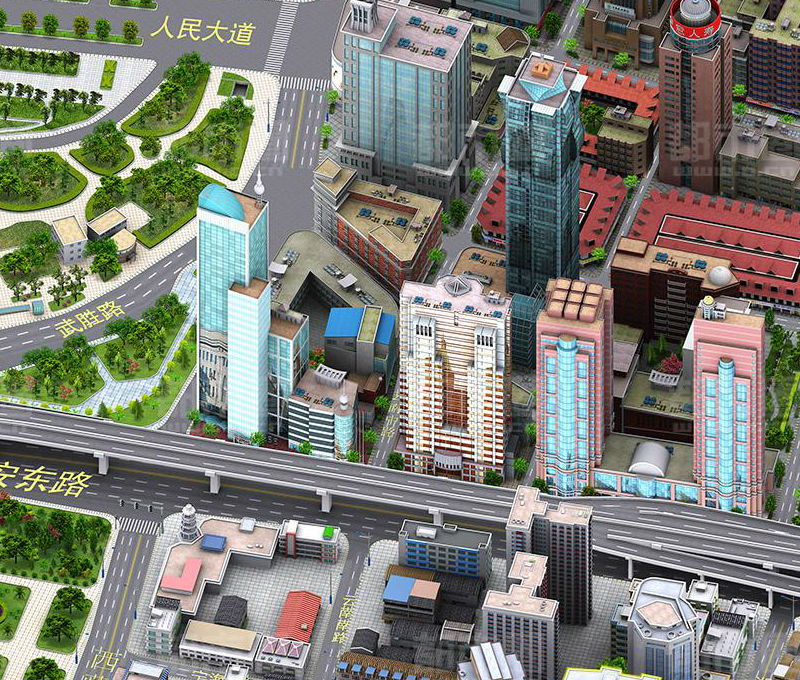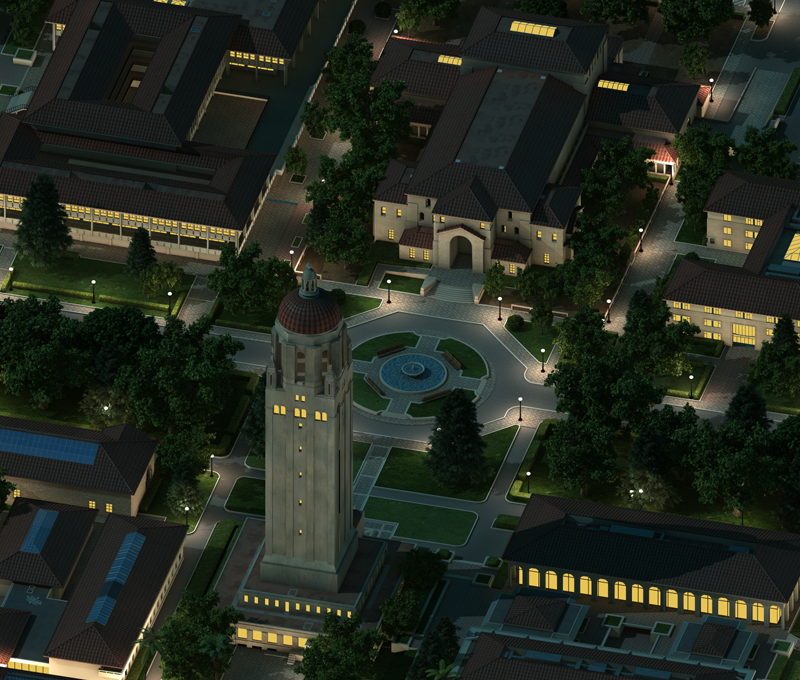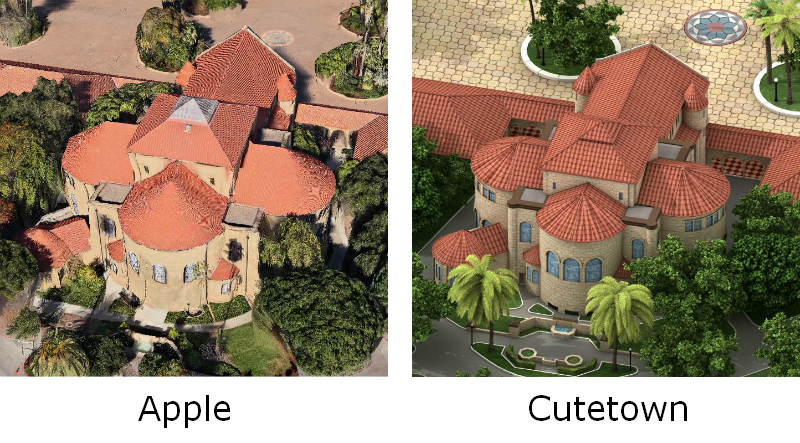"Toy" cartography or 3D maps with their own hands
About fifteen years ago on habré post about unique cards, the Chinese search engine Baidu (for those who haven't seen, here it is: http://habrahabr.ru/post/115107/). I was amazed at how meticulous, detailed and beautiful these cards are made, so one day we, along with a group of friends, decided to look into the process of creating a Baidu-maps and make your own maps all over the world who would look as cool. Under the cut a lot of pictures, the disclosure of the secret Baidu-like cards that we have.

It is obvious that such things — something entirely new to cartography. They are beautiful, they are interesting, they can be viewed for hours. They are clear, in the end, it's probably easier to find a building where you have an appointment, if on the map you posted detailed copy, not a dull grey rectangle. Similar cards do not only Baidu; here are a few examples offhand: Edushi (shanghai.edushi.com), Kerch (http://gorodkerch.com/map/), even Bing on some zoom levels shows aerial photographs (http://binged.it/O3F5Ez)
From the first glance it is clear that the creation of maps of this level of detail requires huge resources. The first thing to come to mind thoughts about the labor of millions trained the Chinese, who are studious, the pixel draw every building, tree and bench. We started with this (not with search million Chinese painters, and drawing of buildings by the method of pixel-art).
It soon became clear that the creation of even a single house requires an incredible investment of time and effort. We are increasingly convinced that Baidu is a 3d map that they are rendered, and not drawn pixel to pixel diligent Chinese guys. Actually, that map was created in 3d, says a lot: shading between the nearby buildings, the same details and objects, which are located to the camera at a different angle. In the end, on http://www.o.cn/ (manufacturer of maps for Baidu), we found a page that fully confirmed the conjecture: http://gis.o.cn/en/3d-process.html. So, there was no doubt, Baidu is just a very high quality rendered 3d map.
But even the detection technology does not solve all problems — it remained an open question, how and who will fill these cards. Okay, each object doesn't need to draw hands, identical building can not be redrawn from scratch, and only prerendering... However, where to get so detailed, beautiful and detailed models of buildings?
Such questions and the search led us to the decision to make a collaborative map, that is to create it together with users. Just imagine: users draw lines and rectangles in OpenStreetMap or Wikimapia, and beautiful, almost toy model of real estate!
As test object was selected the campus of Stanford University. To see how cool maps can be produced, and to understand the process, we decided first to simulate the terrain itself. During the work over the map of the University, it was found that to obtain image-level Baidu is absolutely real forces v-ray:
We can render not only the view of the city from North to South, and all four of his species, and even more:
Changing the light in the scene, it is easy to get a night view:
3d mad leaves room for detail and nerd — you can draw the layout, lights, bushes, benches, and other delicious things:
In the end, a complete cycle of operation of the application looks like this:
the
Now we are preparing to release in the AppStore beta application, with which users will be able to create a map of San Francisco. We learned how to make pictures superior quality with fine detail and exact geographical position.
In the beginning, we assumed that users would be very interesting to make such cards, but never checked this assumption in practice. Today we first time show our work to a wide range of people, and so I want to ask: it would be interesting to you (Yes, you personally, abrowser) to participate in the implementation of these cards? And we have another question: how/what specifically would you like to use these cards/technology?
Will be glad to any feedback!
View our map here:
the
p.s. Anticipating holivary on the topic “EW, a map of only four types — this is garbage, nothing will ever replace real 3d”: just look at the picture. Here is depicted the same building of the Stanford Church. So it looks fresh 3d maps from Apple and on our map. We think the difference is obvious.

p.p.s. Yesterday we tried to publish on habré, but failed billing GAE and we walked out of the quota.
Article based on information from habrahabr.ru

Search for a solution (like the Chinese did?)
It is obvious that such things — something entirely new to cartography. They are beautiful, they are interesting, they can be viewed for hours. They are clear, in the end, it's probably easier to find a building where you have an appointment, if on the map you posted detailed copy, not a dull grey rectangle. Similar cards do not only Baidu; here are a few examples offhand: Edushi (shanghai.edushi.com), Kerch (http://gorodkerch.com/map/), even Bing on some zoom levels shows aerial photographs (http://binged.it/O3F5Ez)
From the first glance it is clear that the creation of maps of this level of detail requires huge resources. The first thing to come to mind thoughts about the labor of millions trained the Chinese, who are studious, the pixel draw every building, tree and bench. We started with this (not with search million Chinese painters, and drawing of buildings by the method of pixel-art).
It soon became clear that the creation of even a single house requires an incredible investment of time and effort. We are increasingly convinced that Baidu is a 3d map that they are rendered, and not drawn pixel to pixel diligent Chinese guys. Actually, that map was created in 3d, says a lot: shading between the nearby buildings, the same details and objects, which are located to the camera at a different angle. In the end, on http://www.o.cn/ (manufacturer of maps for Baidu), we found a page that fully confirmed the conjecture: http://gis.o.cn/en/3d-process.html. So, there was no doubt, Baidu is just a very high quality rendered 3d map.
Our experiments
But even the detection technology does not solve all problems — it remained an open question, how and who will fill these cards. Okay, each object doesn't need to draw hands, identical building can not be redrawn from scratch, and only prerendering... However, where to get so detailed, beautiful and detailed models of buildings?
Such questions and the search led us to the decision to make a collaborative map, that is to create it together with users. Just imagine: users draw lines and rectangles in OpenStreetMap or Wikimapia, and beautiful, almost toy model of real estate!
As test object was selected the campus of Stanford University. To see how cool maps can be produced, and to understand the process, we decided first to simulate the terrain itself. During the work over the map of the University, it was found that to obtain image-level Baidu is absolutely real forces v-ray:

We can render not only the view of the city from North to South, and all four of his species, and even more:

Changing the light in the scene, it is easy to get a night view:

3d mad leaves room for detail and nerd — you can draw the layout, lights, bushes, benches, and other delicious things:

In the end, a complete cycle of operation of the application looks like this:
the
-
the
- , the User draws the perimeter of the home over satellite maps in OSM. We are building a closed loop and passing it along to Unity and remember the location of the house on the map. the
- In the designer the user creates a model of the building: its texture, placing Windows, doors, Bay Windows, cornices, define the roof shape, a word, transforms a rectangle in the model. When the model is ready, it is sent to the card. Unity will export the scene to obj and sends it to the server. the
- the Server accepts obj, calculates the position of the house on the map, place it in the scene with a map of the city, where already set up the light and created v-ray materials. The server then calculates which tiles of the map has changed due to the staging of the house, putilovo renders it renders SVG for highlights and sends it all to the web server.
Opinion
Now we are preparing to release in the AppStore beta application, with which users will be able to create a map of San Francisco. We learned how to make pictures superior quality with fine detail and exact geographical position.
In the beginning, we assumed that users would be very interesting to make such cards, but never checked this assumption in practice. Today we first time show our work to a wide range of people, and so I want to ask: it would be interesting to you (Yes, you personally, abrowser) to participate in the implementation of these cards? And we have another question: how/what specifically would you like to use these cards/technology?
Will be glad to any feedback!
View our map here:
the
-
the
- cutetown.net — site map Stanford University the
- cutetown.net/hires — hires. On it you can see all the small details such as belostenec, café tables, markup, etc. the
- cutetown.net/sf — map San Francisco, which is preparing for the release of the application
p.s. Anticipating holivary on the topic “EW, a map of only four types — this is garbage, nothing will ever replace real 3d”: just look at the picture. Here is depicted the same building of the Stanford Church. So it looks fresh 3d maps from Apple and on our map. We think the difference is obvious.

p.p.s. Yesterday we tried to publish on habré, but failed billing GAE and we walked out of the quota.